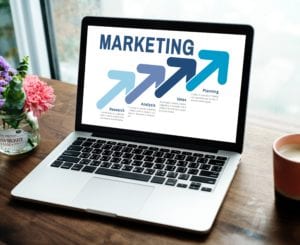In our previous post, we explained the concept of a marketing funnel and how its use can improve your conversion rates. While this statement is true, it’s not the whole picture. A marketing funnel is a very important concept that helps you develop a marketing plan. But concepts need substance in order to make them interesting, and content marketing is the tool that makes your marketing funnel interesting.

How do marketing funnels and content marketing go together?
A marketing funnel is basically a strategy you devise to move someone with no knowledge of your company into being your customer and advocate. This strategy will outline what platforms to use for advertising, what offers will be given to potential customers, and how often you will stay in touch with leads. All these decisions form your marketing plan outline.
Now you need to know what to say and how to say it at each step. This is where content marketing comes into play. You take the outline of your marketing plan and create text to support each stage of the plan. The information provided to potential customers and the timing of this information is crucial for your marketing funnel’s success.
Now, you may think that content marketing and marketing funnels are two concepts that can exist independently of each other. While it may appear that they can, they really can’t. Content for the sake of content is not engaging and a marketing funnel with no substance will have a poor success rate. What you need instead is a blend of the two. A marketing plan provides the criteria that your content marketing must meet in order to make your marketing funnel a success.
A marketing plan provides the criteria that your content marketing must meet in order to make your marketing funnel a success. Click To Tweet
How content marketing can save your marketing funnel
While the marketing funnel can be broken down into complex segments, for the purposes of this article we will take a higher-level approach. The marketing funnel can essentially be broken into three segments: the top of the funnel (the beginning of a lead’s journey), the middle of the funnel (a lead’s journey of decision-making), and the bottom of the funnel (a lead becomes a customer).
Each segment of this funnel will require different content marketing strategies to make it work. We will look at the requirements needed at each stage in order to create a cohesive marketing plan.
Top of the Funnel
This is where it all starts. The goal of this stage is to build brand awareness and to indirectly obtain customers.
At this stage, you do not want to sell your leads anything. This would be comparable to someone running up to you on the street and asking you to buy a computer from them. You have no idea who this person is, or what kind of computer they are selling. The abrupt nature of this sales pitch has turned you off and you want nothing to do with them.
This is the same idea for the top of your marketing funnel. Your leads don’t know you and would be turned off if they are asked to buy something right off the hop. Instead, this is the time to build brand awareness and establish yourself as a subject matter authority. Effective content marketing for this stage include blog posts, webinars, social media updates and infographics.
During this stage, you must realize that you are speaking to a very broad audience. Some of these leads will turn into customers and some will not. Your job is to create content that appeals to the masses while also generating enough curiosity to bring stronger leads further into your funnel.
Now, you may be wondering why your content should start on a general note. The answer is that even though someone may not buy from you, they could potentially recommend you to someone else. Therefore, you want to establish yourself as a subject matter expert and keep yourself top of mind with everyone, not just your immediate customer pool.
Middle of the Funnel
During this phase, a lead now knows about your company and is looking for more information in order to decide.
At this stage, your audience has narrowed to more serious leads, who are better known as warm leads. These leads are familiar with the basics and are looking for more information. During this stage, you can start to use industry jargon in your explanations as well as technical information. Leads are looking for this level of detail to decide whether your product or service meets their requirements, so you won’t scare them away by inserting this type of content.
It’s at this stage that you can also start soft selling. You can demonstrate how your product solves a problem for your audience and how it does it better than your competition.
During this stage, content marketing types that work well include case studies, free ebooks, software download trials, webinars and downloadable templates.
Bottom of the Funnel
This stage is what it is all about. You have spent the time priming your audience and nurturing your leads and this is where all that hard work pays off. At this stage, your leads will finally make the decision whether to convert into customers or not.
This is the narrowest section of your funnel and those leads that remain are the most likely to become customers. Therefore, its your job to convince them they are making the right decision by doing so.
The types of content marketing that work well at this stage include testimonials, spec sheets, and reviews. These types of content help reassure the lead that you are offering a quality product and that others have found benefit what you are offering.
Final Thoughts
Content marketing is a critical piece of any marketing funnel. Being able to provide the right types of content at the right point of the sale can make all the difference in a lead becoming a customer.
If you come on too strong with detailed sales jargon at the beginning, you can scare leads away. The reverse can happen at the end and information that is too simplistic at the end can result in a lead not having the confidence in your product or service to decide to become a customer. Therefore, having a solid content marketing strategy is crucial for your marketing funnel’s success.
———-
In plain terms, WordPress (WP) is simply the top free platform upon which one can create
fantastic fully-featured websites or blogs of any size (best among both free or paid solutions).
Learn more about WordPress here.
***Gain more insight about how to install WordPress & your options.***
If you would like to consider working with us on our Premium or Standard Plans on a ongoing monthly basis, then we can do the job FREE as a trial (with no credit card required and assumes you have a interest potentially becoming a Standard or Premium Plan member . . . otherwise, please use the single one-off job option below).
See here: https://www.wpwebsitehelp.com/#plansandpricing
OR
2. If you only need us to do this one job only, then checkout here for this one-off single job.
See here: https://www.wpwebsitehelp.com/single-one-job/
Our plans can cover ongoing maintenance & annoying regular task items, of which, you should not spend your valuable time! This gives you peace of mind so you can focus your mind on your endeavor. We have you covered whether it is WordPress help or WordPress support for a business, personal, student, education, non-profit, or ministry endeavor.
Here are some examples along with HOW it works at WP Website Help.
Here are a few FAQ’s & our about us.
Jolene is a strong operations, compliance, and paralegal manager. She also loves to research and write about business as well as personal topics that help others.
Jolene @ The WP Website Help Team

